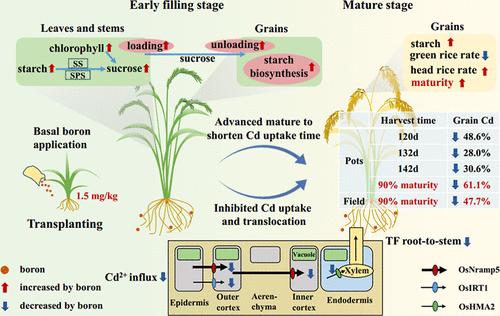Boron’s Role in Diminishing Cadmium Concentrations in Rice (Oryza sativa L.): Insights into Absorption Inhibition and Ripening Promotion
IF 6.2
1区 农林科学
Q1 AGRICULTURE, MULTIDISCIPLINARY
引用次数: 0
Abstract
Boron, a crucial element for plant growth, has been demonstrated to mitigate cadmium (Cd) absorption in rice seedlings. However, its impact on Cd accumulation in rice grains and the underlying regulatory mechanisms remain poorly understood. The current study explored the roles of boron in reducing Cd accumulation and promoting ripening in rice through pot and hydroponic experiments. The results revealed that the basal boron application (1.5 mg kg–1) decreased grain Cd concentration by 61.1%, primarily due to the synergistic effects of inhibited Cd uptake and transport, along with increased maturation. Boron mitigated the root Cd2+ influx by 32.4% and transport factors by 36.0–47.3% primarily by downregulating the expression of OsNramp5, OsIRT1, and OsHMA2. Moreover, boron enhanced the activities of key sucrose-metabolizing enzymes and increased the relative expression levels of genes associated with sugar metabolism and transport, thereby shortening the rice growth period from 132 to 120 d. Field experiment confirmed that boron application decreased rice grain Cd concentration by 47.7% while promoting earlier maturation. This study elucidates the mechanism behind boron’s ability to lower grain Cd levels and highlights its potential as an effective agronomic approach to mitigate food safety risks in rice grown on Cd-contaminated paddy soils.

硼在降低水稻(Oryza sativa L.)镉浓度中的作用:对吸收抑制和促进成熟的见解
硼是植物生长的关键元素,已被证明可以减轻水稻幼苗对镉(Cd)的吸收。然而,其对水稻籽粒镉积累的影响及其调控机制尚不清楚。本研究通过盆栽和水培试验,探讨硼在减少水稻Cd积累和促进成熟中的作用。结果表明,基施硼(1.5 mg kg-1)使籽粒Cd浓度降低61.1%,主要是由于抑制Cd吸收和转运的协同作用,以及成熟的增加。硼主要通过下调OsNramp5、OsIRT1和OsHMA2的表达,使根Cd2+内流减少32.4%,运输因子减少36.0 ~ 47.3%。此外,硼提高了关键蔗糖代谢酶的活性,提高了糖代谢和转运相关基因的相对表达水平,从而使水稻生育期从132 d缩短至120 d。田间试验证实,施用硼使水稻籽粒Cd浓度降低了47.7%,促进了早熟。本研究阐明了硼降低籽粒Cd水平的机制,并强调了硼作为一种有效的农艺方法在镉污染水稻土壤上种植的水稻中降低食品安全风险的潜力。
本文章由计算机程序翻译,如有差异,请以英文原文为准。
求助全文
约1分钟内获得全文
求助全文
来源期刊
CiteScore
9.90
自引率
8.20%
发文量
1375
审稿时长
2.3 months
期刊介绍:
The Journal of Agricultural and Food Chemistry publishes high-quality, cutting edge original research representing complete studies and research advances dealing with the chemistry and biochemistry of agriculture and food. The Journal also encourages papers with chemistry and/or biochemistry as a major component combined with biological/sensory/nutritional/toxicological evaluation related to agriculture and/or food.

 求助内容:
求助内容: 应助结果提醒方式:
应助结果提醒方式:


